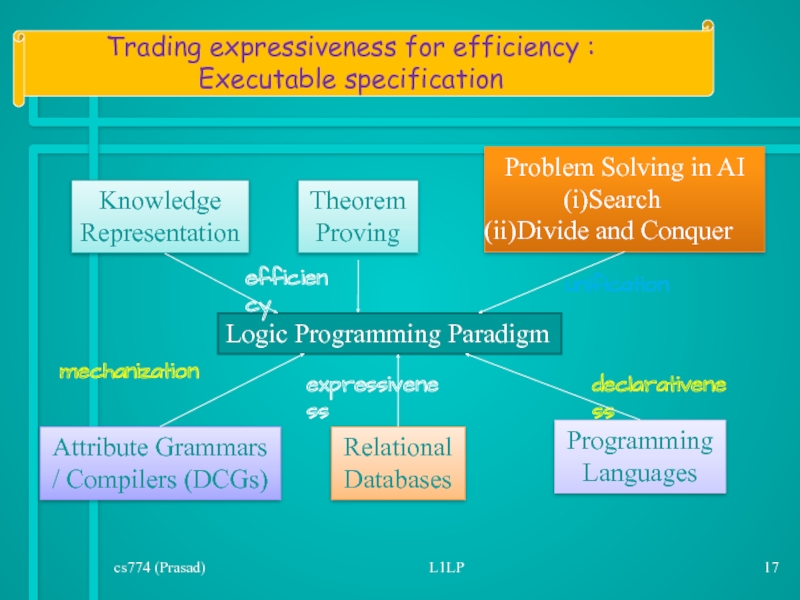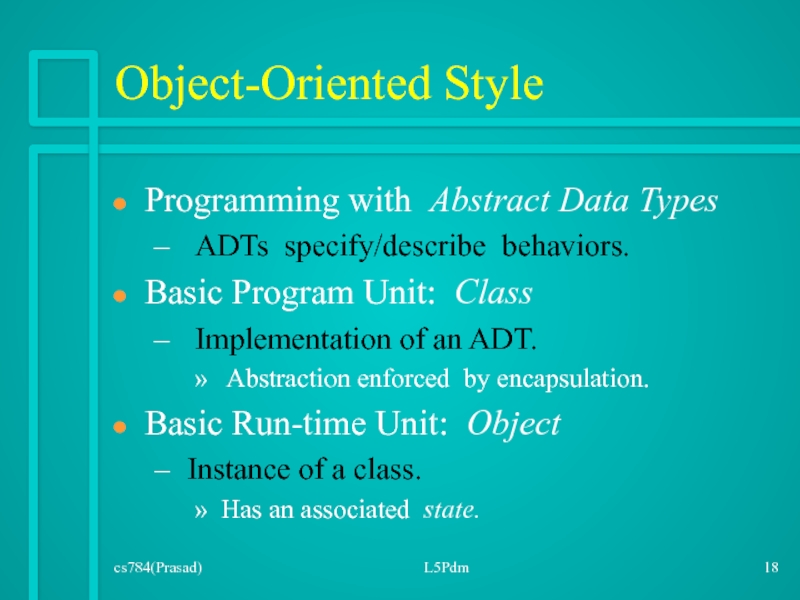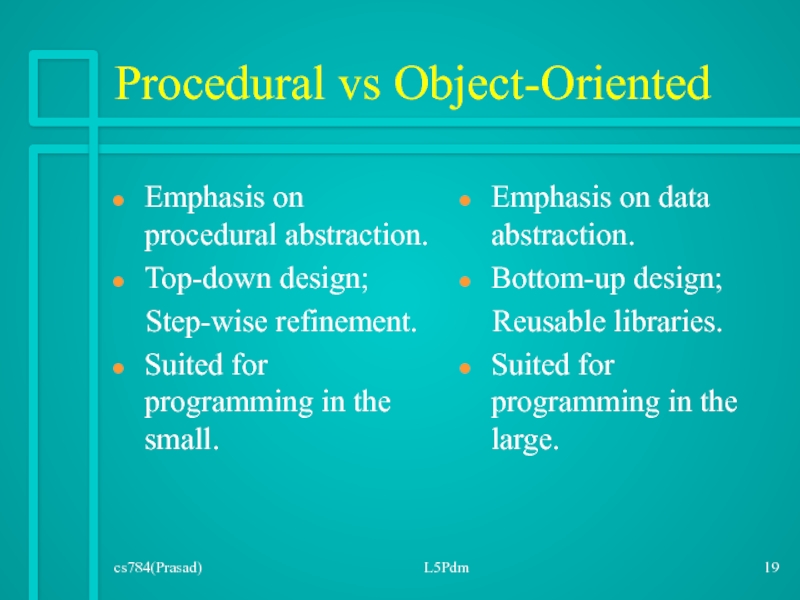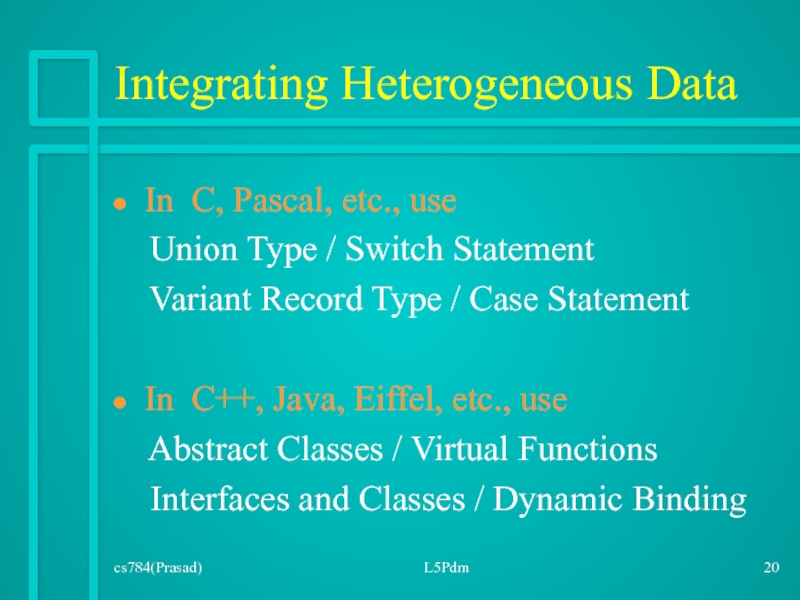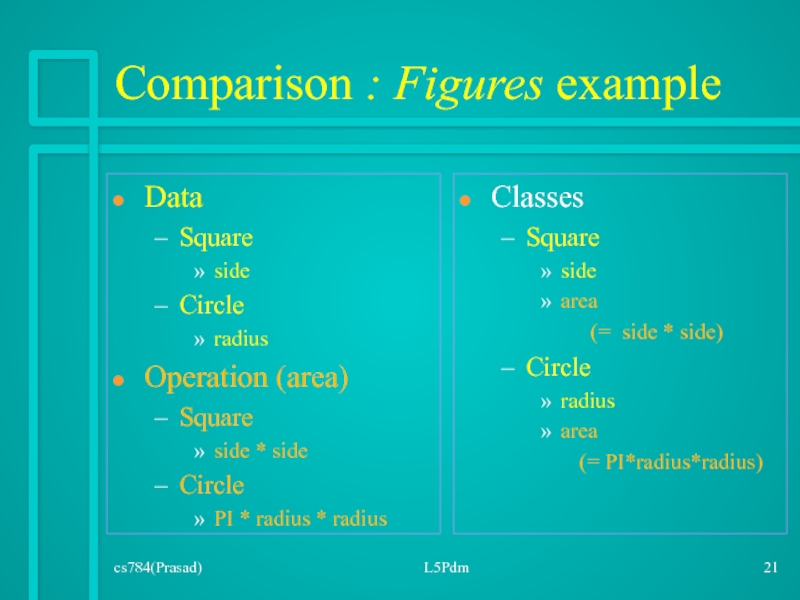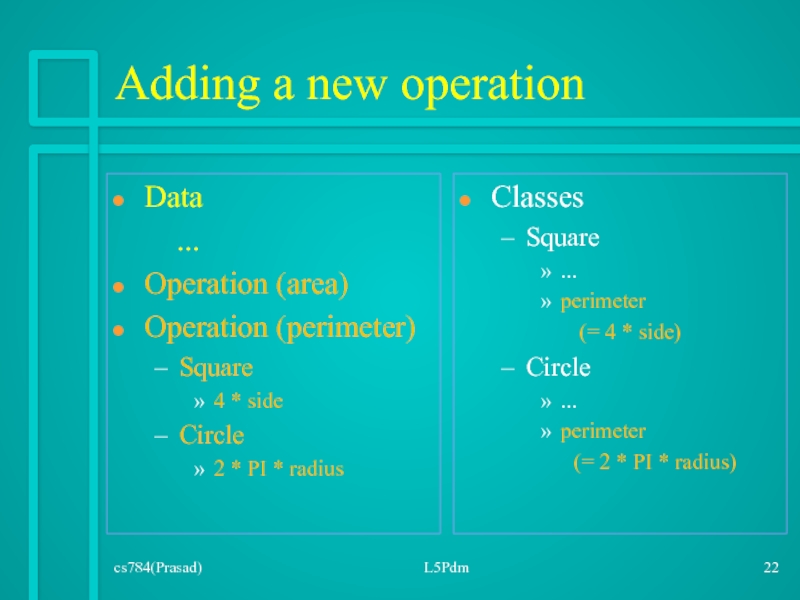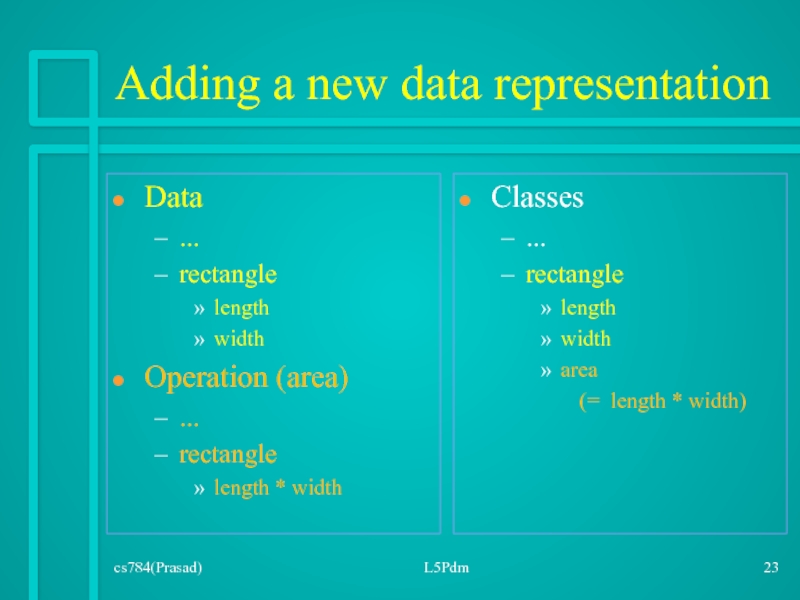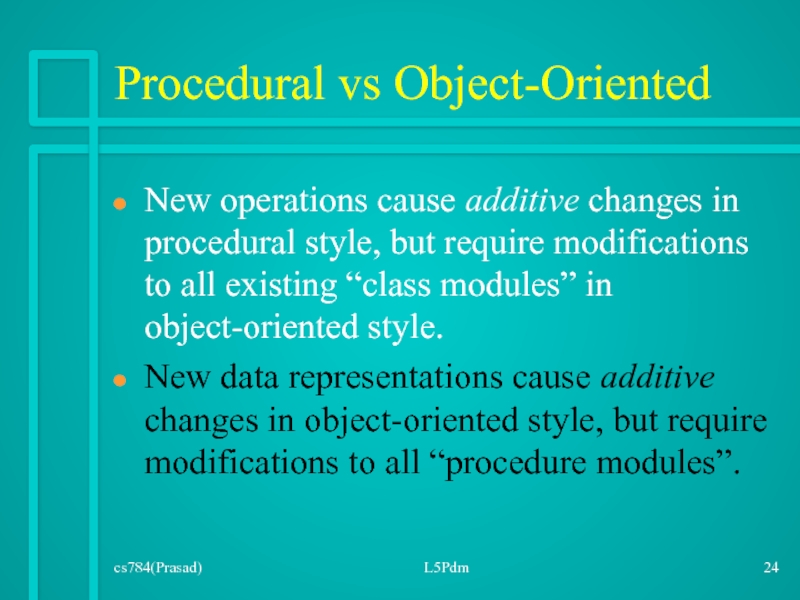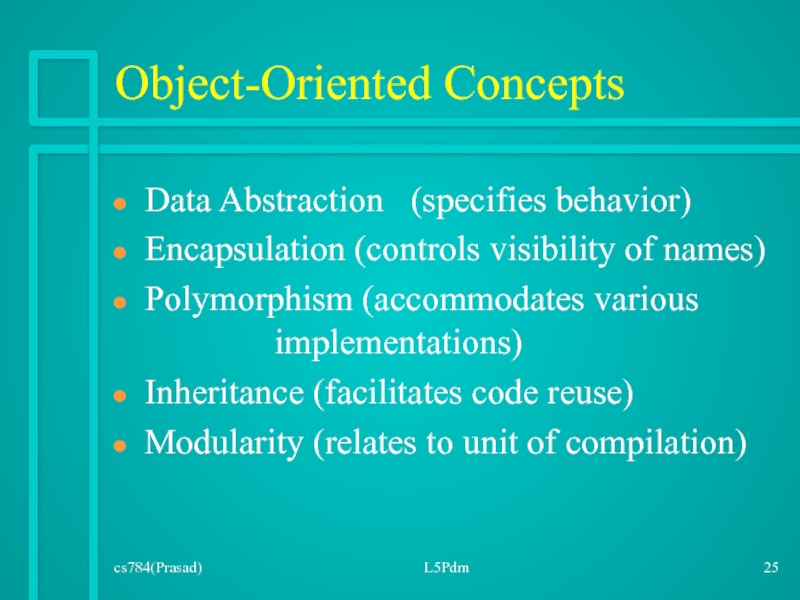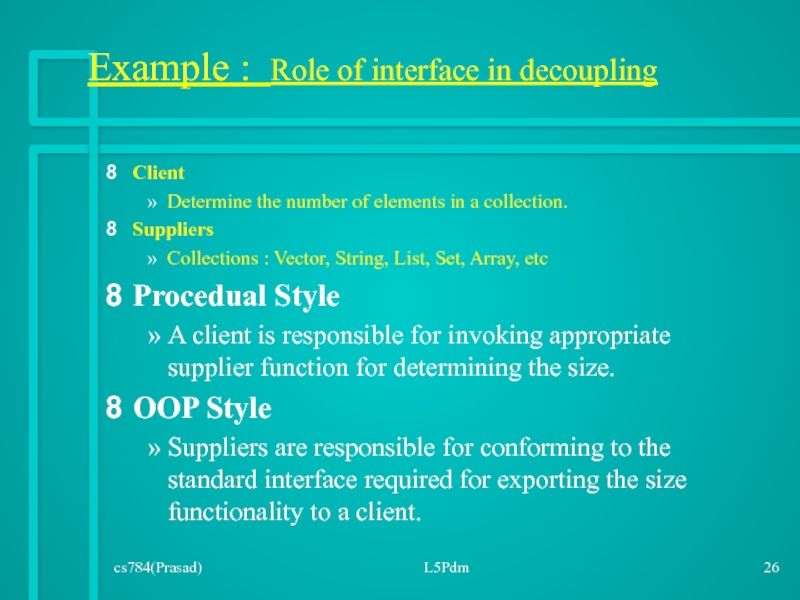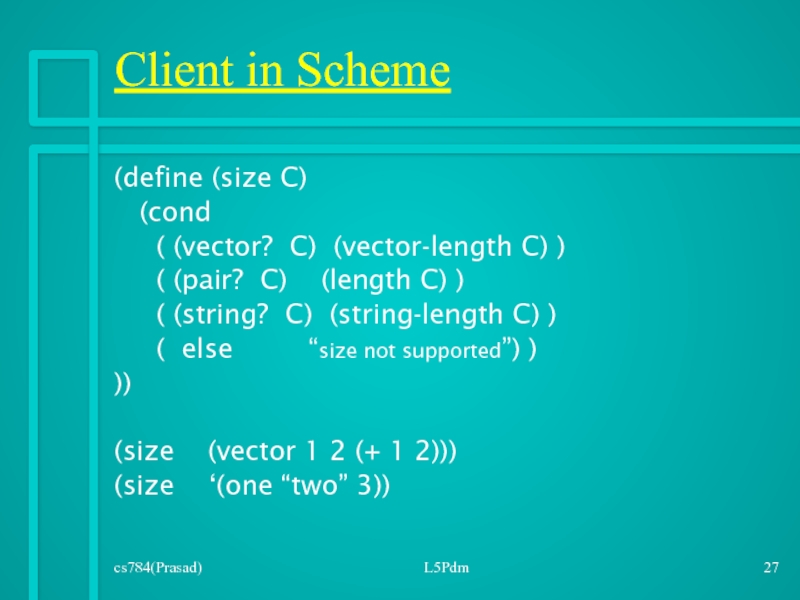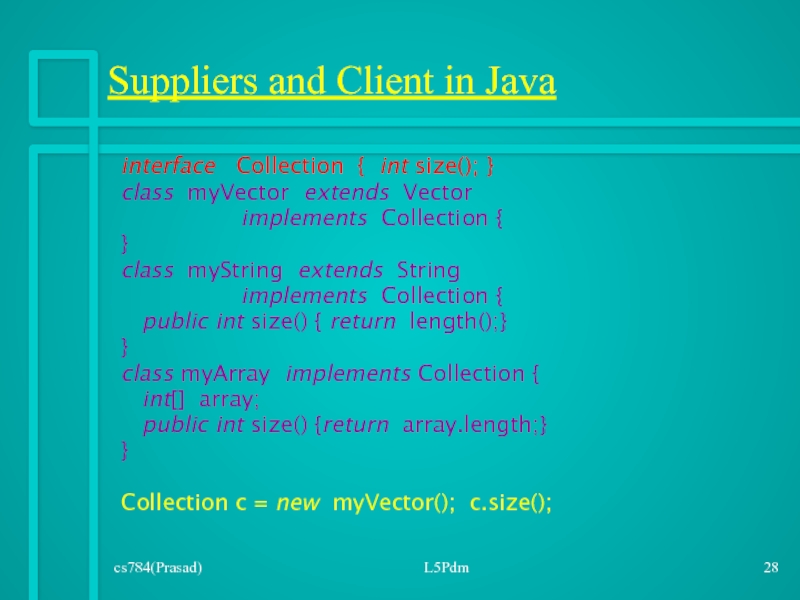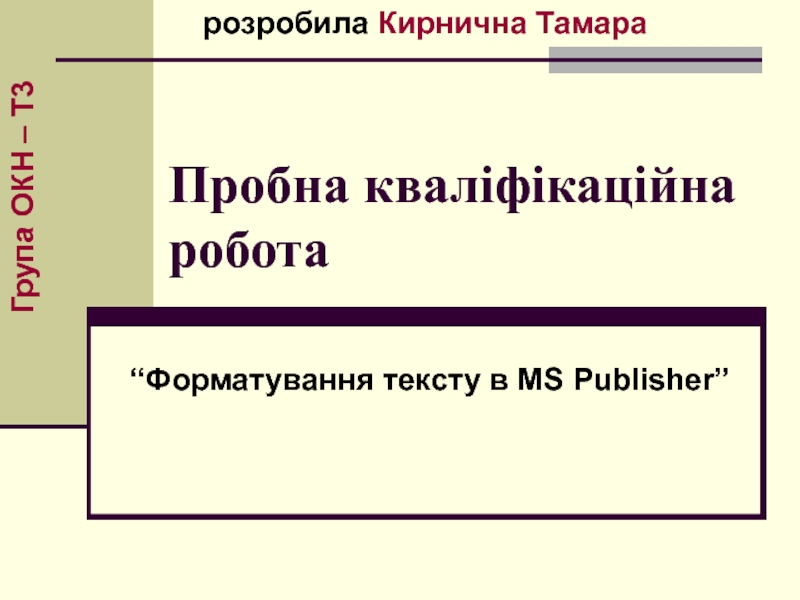- Главная
- Разное
- Дизайн
- Бизнес и предпринимательство
- Аналитика
- Образование
- Развлечения
- Красота и здоровье
- Финансы
- Государство
- Путешествия
- Спорт
- Недвижимость
- Армия
- Графика
- Культурология
- Еда и кулинария
- Лингвистика
- Английский язык
- Астрономия
- Алгебра
- Биология
- География
- Детские презентации
- Информатика
- История
- Литература
- Маркетинг
- Математика
- Медицина
- Менеджмент
- Музыка
- МХК
- Немецкий язык
- ОБЖ
- Обществознание
- Окружающий мир
- Педагогика
- Русский язык
- Технология
- Физика
- Философия
- Химия
- Шаблоны, картинки для презентаций
- Экология
- Экономика
- Юриспруденция
Programming paradigms презентация
Содержание
- 1. Programming paradigms
- 2. Programming Paradigm A way of
- 3. cs784(Prasad) L5Pdm Imperative vs Non-Imperative Functional/Logic
- 4. cs784(Prasad) L5Pdm Illustrative Example Expression (to be
- 5. cs784(Prasad) L5Pdm Imperative vs Non-Imperative Functional/Logic style
- 6. cs784(Prasad) L5Pdm Procedural vs Functional Program:
- 7. cs784(Prasad) L5Pdm Functional Style : Illustration Definition
- 8. cs784(Prasad) L5Pdm Paradigm vs Language Imperative Style
- 9. cs784(Prasad) L5Pdm Role of Variables Imperative (read/write)
- 10. cs784(Prasad) L5Pdm Bridging the Gap Tail recursive
- 11. cs784(Prasad) L5Pdm Analogy: Styles vs Formalisms
- 12. cs784(Prasad) L5Pdm Logic Programming Paradigm Integrates Data
- 13. cs784(Prasad) L5Pdm Declarative Programming A logic
- 14. cs784(Prasad) L5Pdm Append in Prolog
- 15. cs784(Prasad) L5Pdm Different Kinds of Queries
- 16. cs784(Prasad) L5Pdm More Queries Constraint solving sig:
- 17. cs774 (Prasad) L1LP Trading expressiveness for efficiency : Executable specification
- 18. cs784(Prasad) L5Pdm Object-Oriented Style Programming with Abstract
- 19. cs784(Prasad) L5Pdm Procedural vs Object-Oriented Emphasis on
- 20. cs784(Prasad) L5Pdm Integrating Heterogeneous Data In C,
- 21. cs784(Prasad) L5Pdm Comparison : Figures example Data
- 22. cs784(Prasad) L5Pdm Adding a new operation Data
- 23. cs784(Prasad) L5Pdm Adding a new data representation
- 24. cs784(Prasad) L5Pdm Procedural vs Object-Oriented New operations
- 25. cs784(Prasad) L5Pdm Object-Oriented Concepts Data Abstraction
- 26. cs784(Prasad) L5Pdm Example : Role of interface
- 27. cs784(Prasad) L5Pdm Client in Scheme (define (size
- 28. cs784(Prasad) L5Pdm Suppliers and Client in Java
Слайд 2Programming Paradigm
A way of conceptualizing what it means to
Imperative : Machine-model based
Functional : Equations; Expression Evaluation
Logical : First-order Logic Deduction
Object-Oriented : Programming with Data Types
cs784(Prasad)
L5Pdm
Слайд 3cs784(Prasad)
L5Pdm
Imperative vs Non-Imperative
Functional/Logic programs specify WHAT is to be computed
In constrast, Imperative programs describe
the details of HOW the results are to be obtained, in terms of the underlying machine model.
Слайд 4cs784(Prasad)
L5Pdm
Illustrative Example
Expression (to be computed) : a + b + c
Recipe
Intermediate Code
T := a + b; T := T + c;
Accumulator Machine
Load a; Add b; Add c
Stack Machine
Push a; Push b; Add; Push c; Add
Слайд 5cs784(Prasad)
L5Pdm
Imperative vs Non-Imperative
Functional/Logic style clearly separates WHAT aspects of a program
An Imperative program contains both the specification and the implementation details, inseparably inter-twined.
Слайд 6cs784(Prasad)
L5Pdm
Procedural vs Functional
Program: a sequence of instructions for a von
Computation by instruction execution.
Iteration.
Modifiable or updateable variables.
Program: a collection of function definitions (m/c independent).
Computation by term rewriting.
Recursion.
Assign-only-once variables.
Слайд 7cs784(Prasad)
L5Pdm
Functional Style : Illustration
Definition : Equations
sum(0) = 0
sum(n) = n
Computation : Substituition and Replacement
sum(2)
= 2 + sum (2-1)
= …
= 3
Слайд 8cs784(Prasad)
L5Pdm
Paradigm vs Language
Imperative Style
i := 0; sum
while (i < n) do
i := i + 1;
sum := sum + i
end;
Storage efficient
Functional Style
func sum(i:int) : int;
if i = 0
then 0
else i + sum(i-1)
end;
No Side-effect
Слайд 9cs784(Prasad)
L5Pdm
Role of Variables
Imperative (read/write)
i
sum 0 1 3 6 ...
Functional (read only)
i1 sum1
i2 sum2
i3 sum3
...
3
2
1
6
3
1
Слайд 10cs784(Prasad)
L5Pdm
Bridging the Gap
Tail recursive programs can be auomatically optimized for space
func sum(i : int, r : int) : int;
if i = 0 then r
else sum(i-1, n+r)
end
Scheme does not have loops.
Слайд 11cs784(Prasad)
L5Pdm
Analogy: Styles vs Formalisms
Iteration
Tail-Recursion
General Recursion
Regular Expression
Regular Grammar
Context-free Grammar
Слайд 12cs784(Prasad)
L5Pdm
Logic Programming Paradigm
Integrates Data and Control Structures
edge(a,b).
edge(c,a).
path(X,X).
path(X,Y) :- edge(X,Y).
path(X,Y) :- edge(X,Z), path(Z,Y).
Слайд 13cs784(Prasad)
L5Pdm
Declarative Programming
A logic program defines a set of relations.
In contrast, the programs in other languages
make explicit HOW the “declarative knowledge” is used to solve the query.
Слайд 14cs784(Prasad)
L5Pdm
Append in Prolog
append([], L, L).
append([ H
append(T, L, R).
True statements about append relation.
“.” and “:-” are logical connectives that stand for “and” and “if” respectively.
Uses pattern matching.
“[]” and “|” stand for empty list and cons operation.
Слайд 15cs784(Prasad)
L5Pdm
Different Kinds of Queries
Verification
sig: list x list x list
append([1],
Concatenation
sig: list x list -> list
append([1], [2,3], R).
Слайд 16cs784(Prasad)
L5Pdm
More Queries
Constraint solving
sig: list x list -> list
append( R,
sig: list -> list x list
append(A, B, [1,2,3]).
Generation
sig: -> list x list x list
append(X, Y, Z).
Слайд 18cs784(Prasad)
L5Pdm
Object-Oriented Style
Programming with Abstract Data Types
ADTs specify/describe behaviors.
Basic Program Unit:
Implementation of an ADT.
Abstraction enforced by encapsulation.
Basic Run-time Unit: Object
Instance of a class.
Has an associated state.
Слайд 19cs784(Prasad)
L5Pdm
Procedural vs Object-Oriented
Emphasis on procedural abstraction.
Top-down design;
Step-wise refinement.
Suited for
Emphasis on data abstraction.
Bottom-up design;
Reusable libraries.
Suited for programming in the large.
Слайд 20cs784(Prasad)
L5Pdm
Integrating Heterogeneous Data
In C, Pascal, etc., use
Union Type /
Variant Record Type / Case Statement
In C++, Java, Eiffel, etc., use
Abstract Classes / Virtual Functions
Interfaces and Classes / Dynamic Binding
Слайд 21cs784(Prasad)
L5Pdm
Comparison : Figures example
Data
Square
side
Circle
radius
Operation (area)
Square
side * side
Circle
PI * radius *
Classes
Square
side
area
(= side * side)
Circle
radius
area
(= PI*radius*radius)
Слайд 22cs784(Prasad)
L5Pdm
Adding a new operation
Data
...
Operation (area)
Operation (perimeter)
Square
4 *
Circle
2 * PI * radius
Classes
Square
...
perimeter
(= 4 * side)
Circle
...
perimeter
(= 2 * PI * radius)
Слайд 23cs784(Prasad)
L5Pdm
Adding a new data representation
Data
...
rectangle
length
width
Operation (area)
...
rectangle
length * width
Classes
...
rectangle
length
width
area
Слайд 24cs784(Prasad)
L5Pdm
Procedural vs Object-Oriented
New operations cause additive changes in procedural style, but
New data representations cause additive changes in object-oriented style, but require modifications to all “procedure modules”.
Слайд 25cs784(Prasad)
L5Pdm
Object-Oriented Concepts
Data Abstraction (specifies behavior)
Encapsulation (controls visibility of names)
Polymorphism (accommodates
Inheritance (facilitates code reuse)
Modularity (relates to unit of compilation)
Слайд 26cs784(Prasad)
L5Pdm
Example : Role of interface in decoupling
Client
Determine the number of elements
Suppliers
Collections : Vector, String, List, Set, Array, etc
Procedual Style
A client is responsible for invoking appropriate supplier function for determining the size.
OOP Style
Suppliers are responsible for conforming to the standard interface required for exporting the size functionality to a client.
Слайд 27cs784(Prasad)
L5Pdm
Client in Scheme
(define (size C)
(cond
( (pair? C) (length C) )
( (string? C) (string-length C) )
( else “size not supported”) )
))
(size (vector 1 2 (+ 1 2)))
(size ‘(one “two” 3))
Слайд 28cs784(Prasad)
L5Pdm
Suppliers and Client in Java
interface Collection { int size(); }
class
implements Collection {
}
class myString extends String
implements Collection {
public int size() { return length();}
}
class myArray implements Collection {
int[] array;
public int size() {return array.length;}
}
Collection c = new myVector(); c.size();
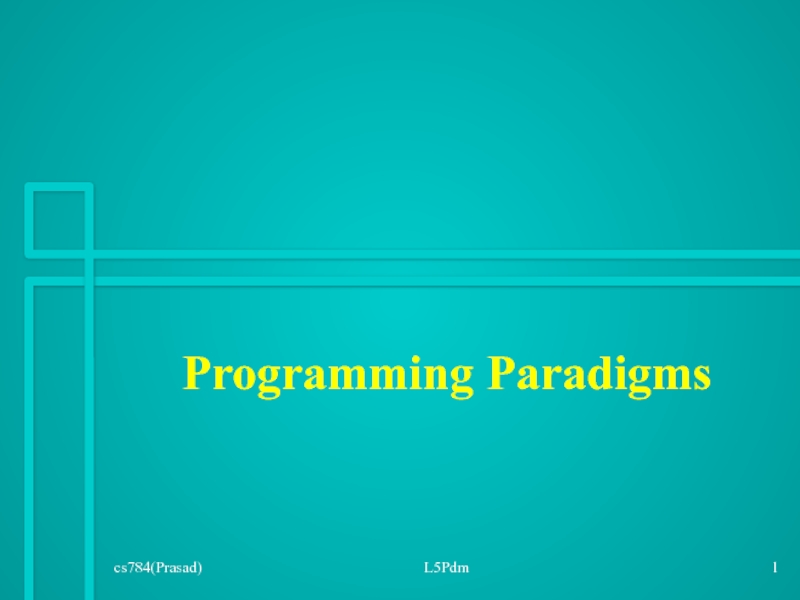
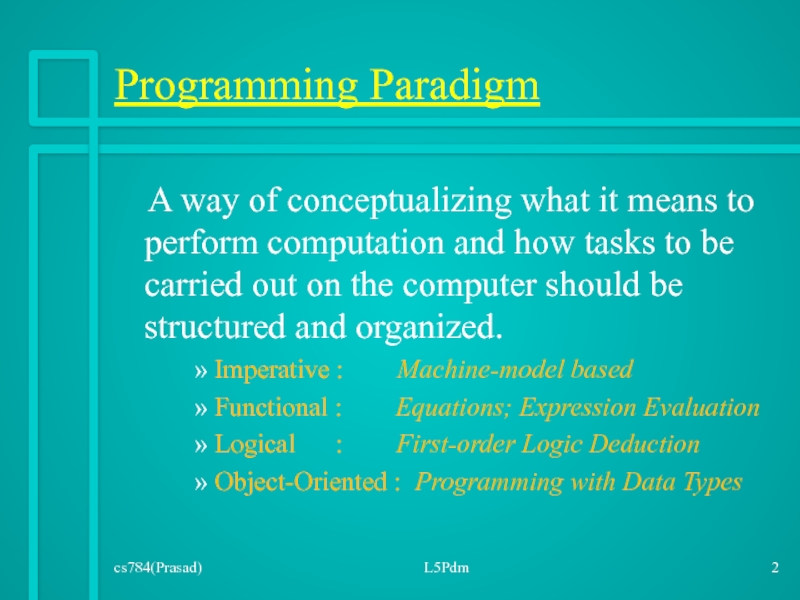
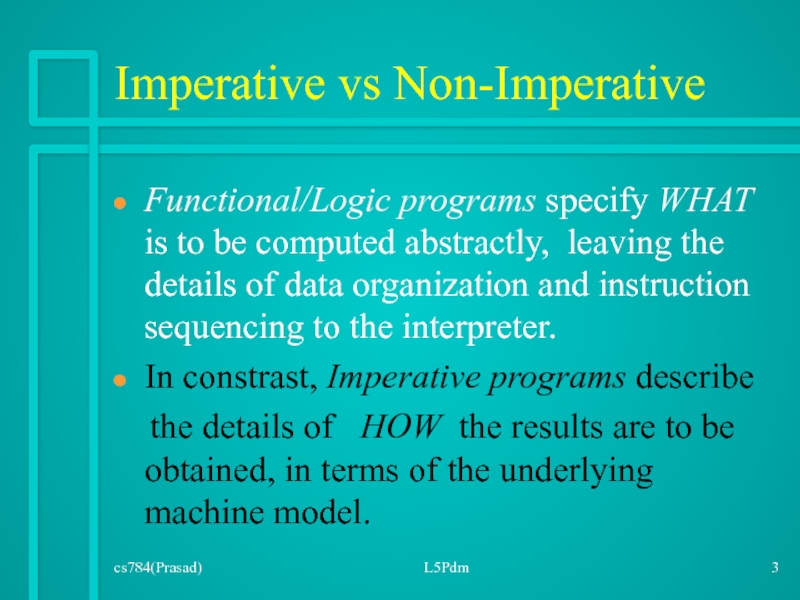
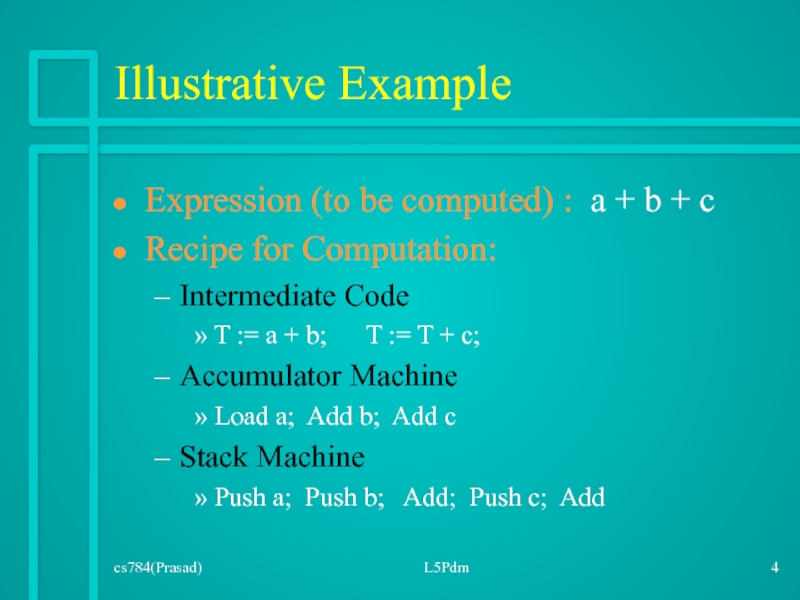
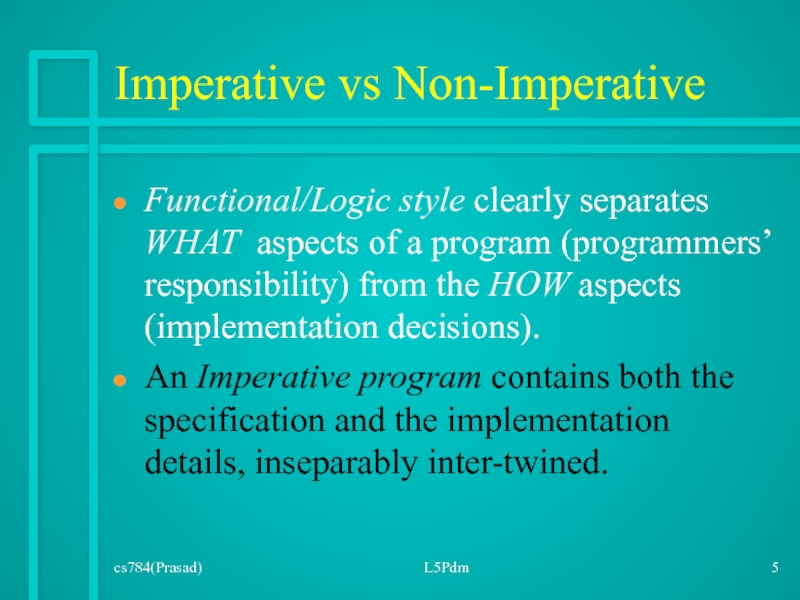
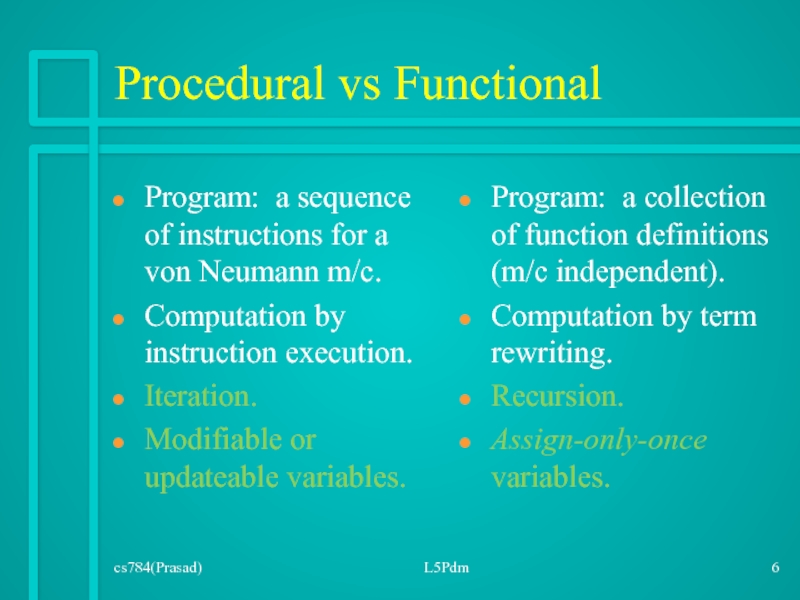
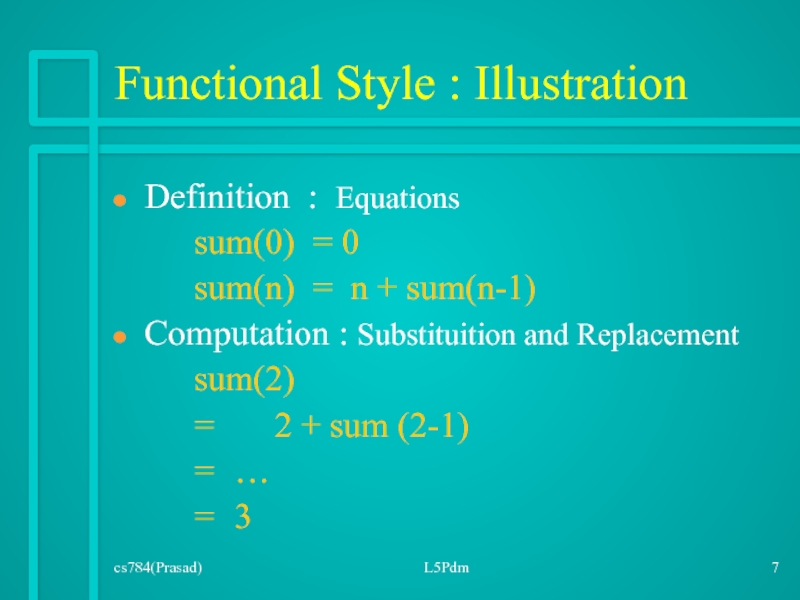
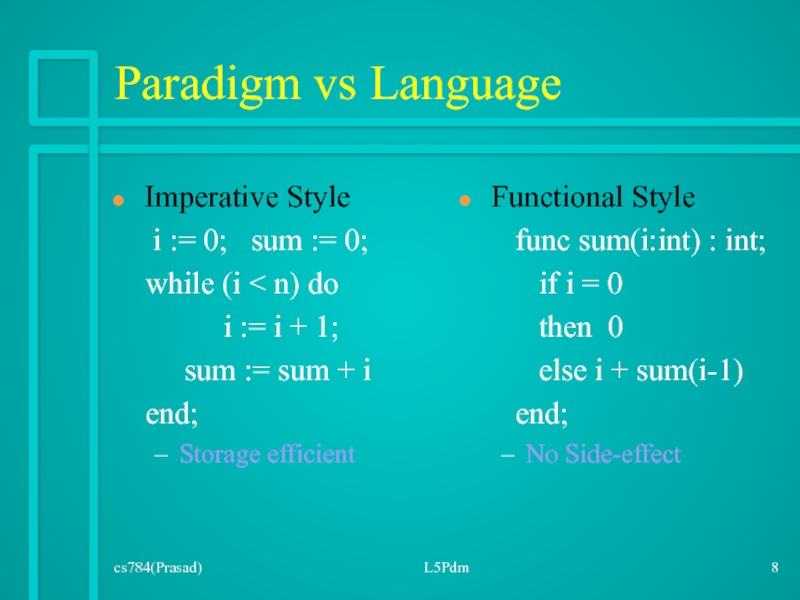
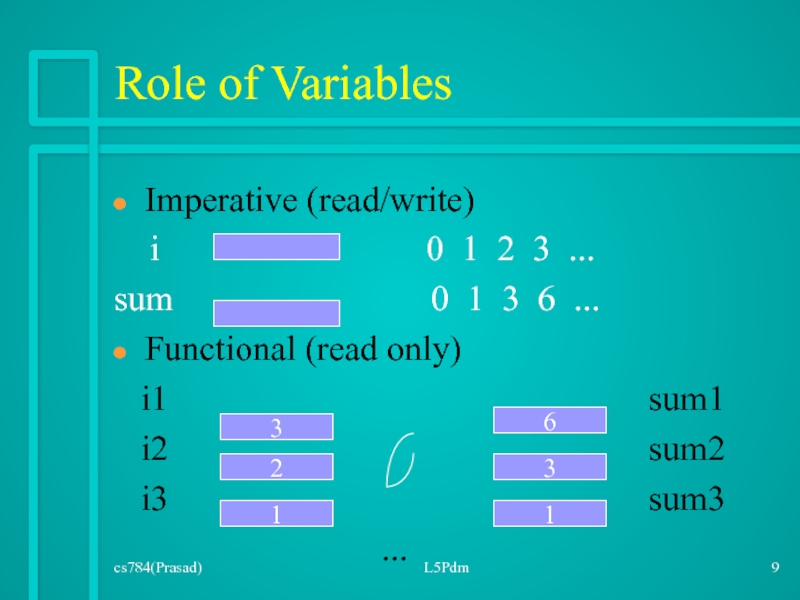
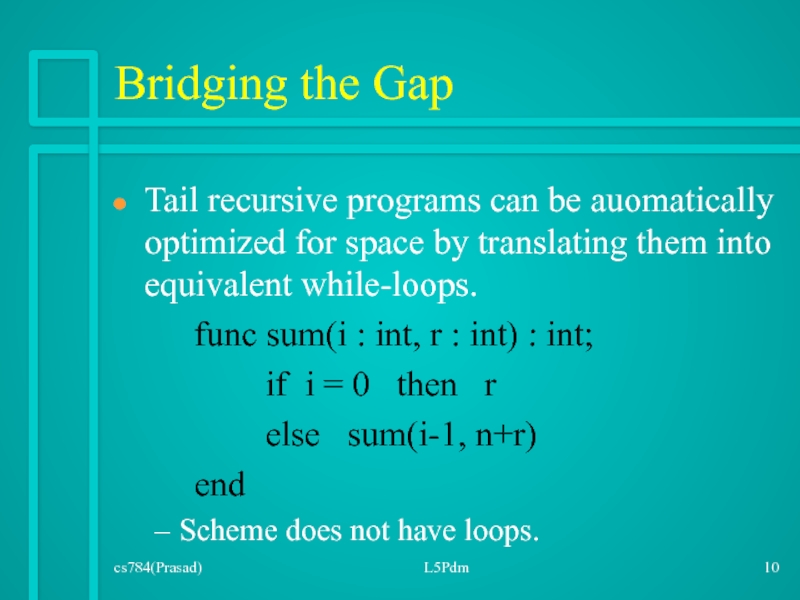
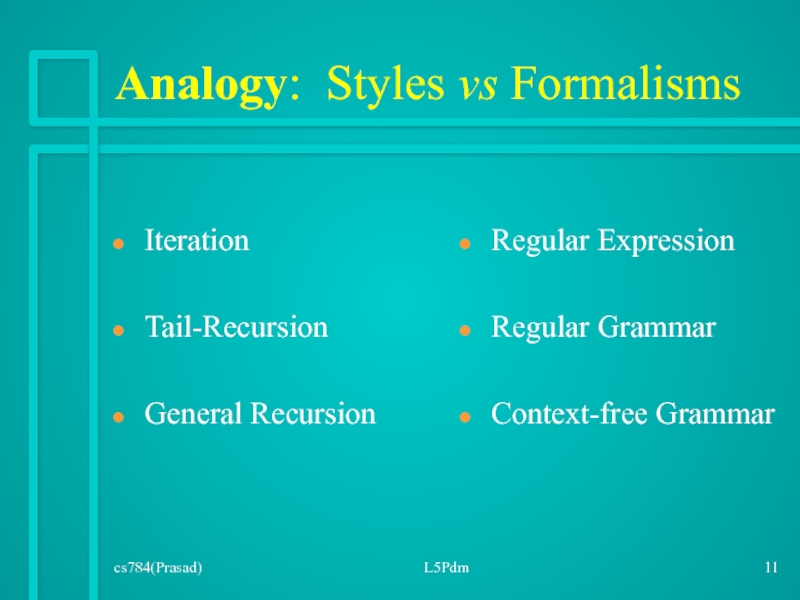
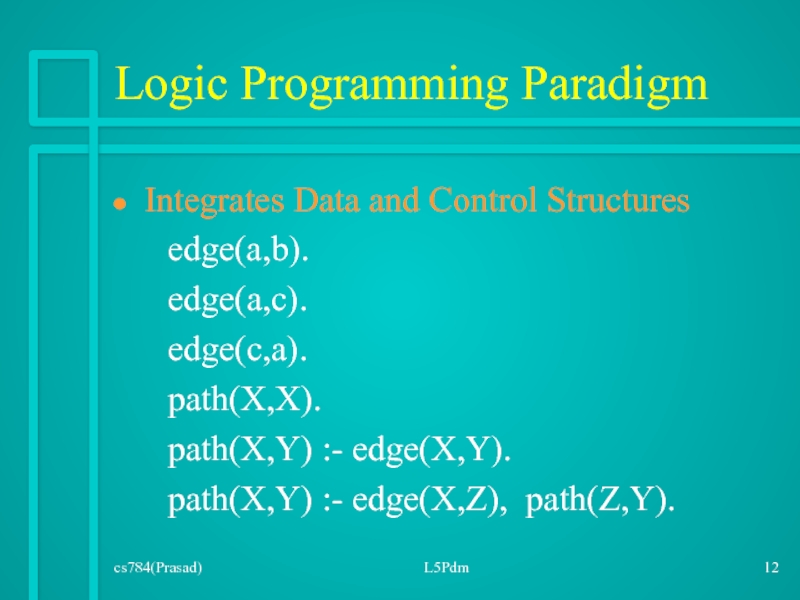
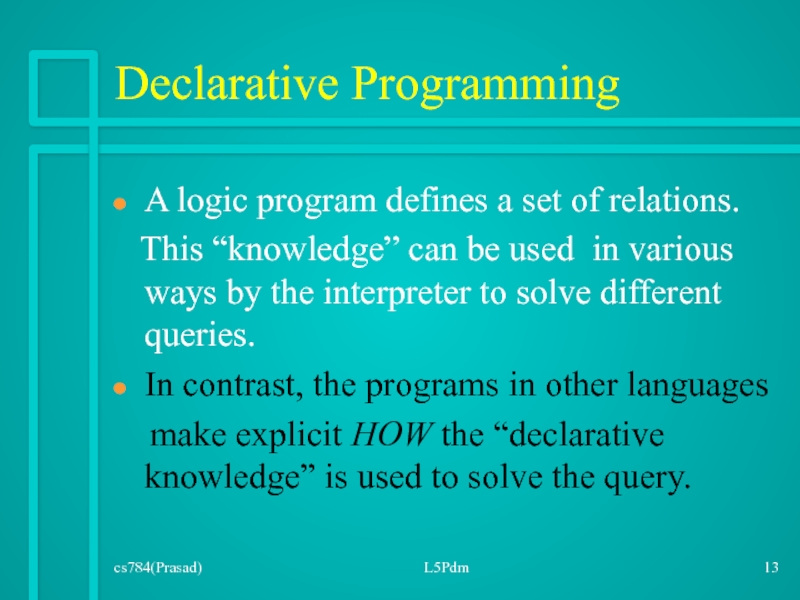
![cs784(Prasad)L5Pdm Append in Prolog append([], L, L). append([ H | T ], L, [ H](/img/tmb/5/418091/fdb6be4dc8e8aa0b4e29b4c4954ea71e-800x.jpg)
![cs784(Prasad)L5PdmDifferent Kinds of Queries Verificationsig: list x list x list append([1], [2,3], [1,2,3]).Concatenationsig: list x](/img/tmb/5/418091/cde266decb3869d9319aca0d5246ebff-800x.jpg)
![cs784(Prasad)L5PdmMore QueriesConstraint solvingsig: list x list -> list append( R, [2,3], [1,2,3]).sig: list -> list](/img/tmb/5/418091/a12c79826192e7faf2dd6b3f87a76790-800x.jpg)
